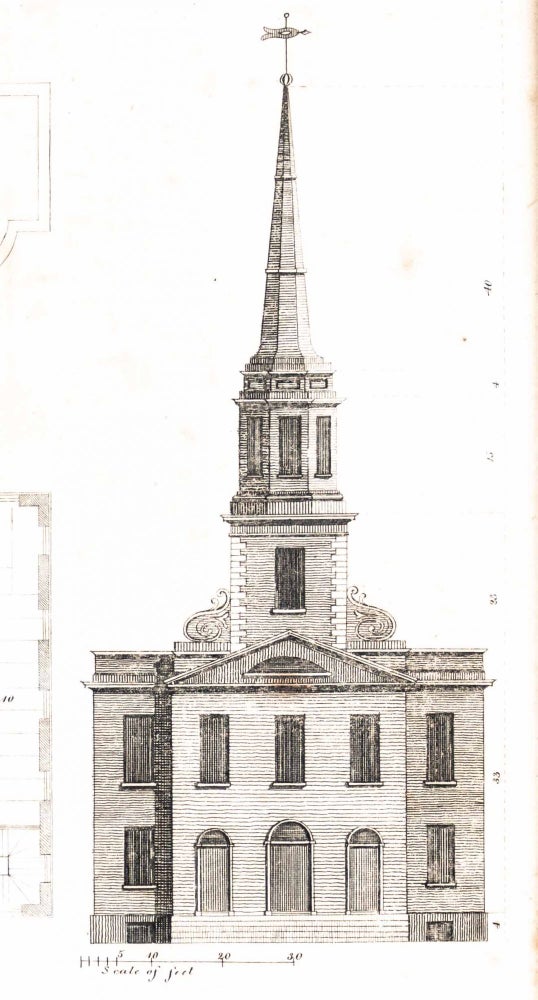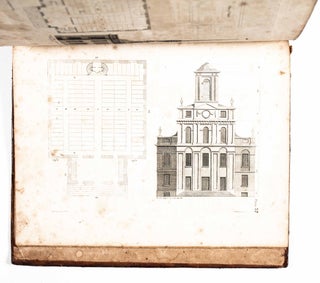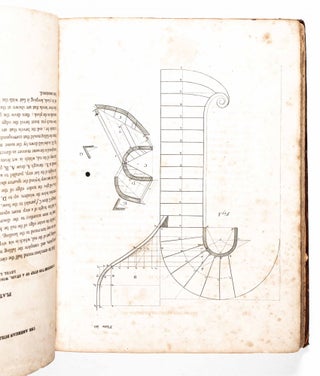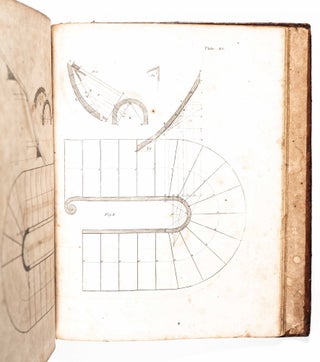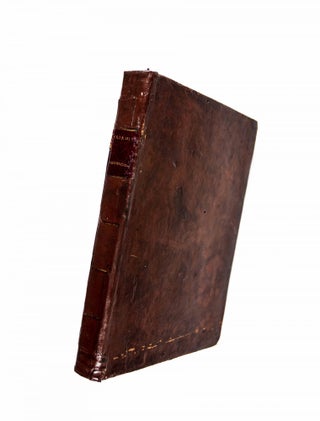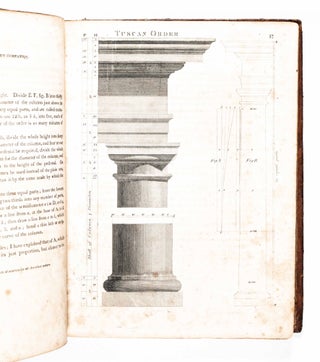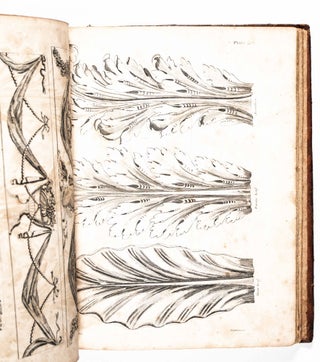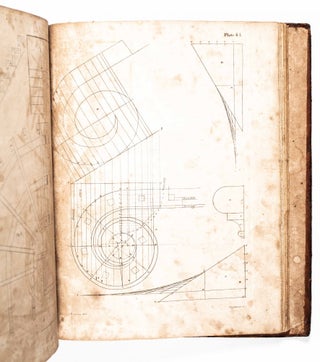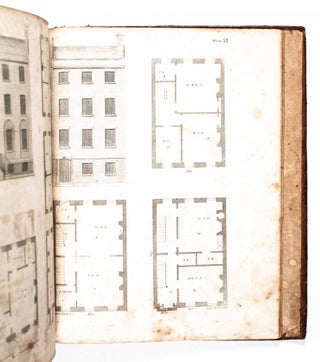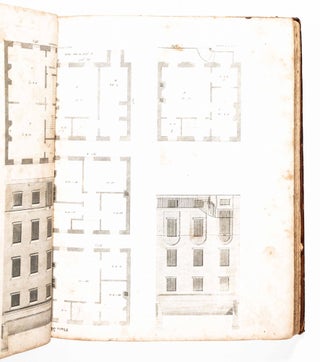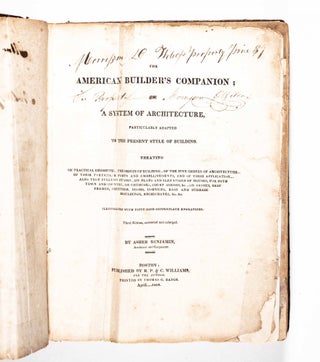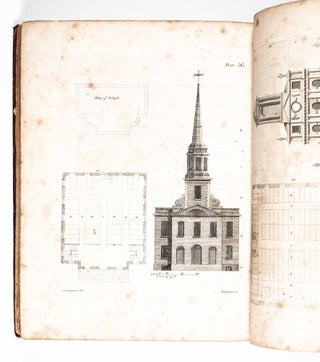The American Builder's Companion; or A System of Architecture, Particularly Adapted To The Present Style of Building
Boston: R. P. & C. Williams for the author, 1816. Third edition, corrected and enlarged. Hardcover. Quarto. iv, 5-104pp. Original rebacked calf with gilt lettering on original red label with gilt ruling on spine. On practical geometry; the origin of building; the five orders of architecture; of their particular parts and embellishments, and of their application; also very fully on stairs; on plans and elevations of houses, & on sashes, sash frames, shutters, doors, cornices, base and surbase mouldings, architraves, etc. Printed by Thomas G. Bangs and illustrated with fifty-nine copperplate engravings by Daniel Raynerd.
"Five years having elapsed since the first publication of the American Builder; during which time I have been constantly employed in drawing and executing plans for buildings. The experience of that time enables me to confirm some, and reject other former methods. Sixteen plates, which were in the first edition, I have laid aside, and have added twenty nine new ones; which almost make this a new work." (Benjamin in his preface)
The first edition of the American Builder in 1806 was published under Benjamin's and the name of Daniel Raynerd who had provided the drawings included in that edition. A note in the 1811 second edition clarifies the extent of Raynerd's involvement, that is to have drawn the plates for the 1806 publication. Benjamin refers to the 1811 edition in our preface as the first edition though it was the first edition exclusively published under his name.
The Builder's Companion contains an essay on "The origin of buildings," "Of the parts which compose the orders of architecture, and of their properties, applications, and embellishments" and "Of the order of architecture in general."
Benjamin's influence on the architecture throughout New England is well documented, as Benjamin has inspired countless builders and was identified as the architect of important buildings in Massachusetts and Connecticut. The American Builder's Companion became Benjamin's most popular book and was published in six editions by 1827.
Provenance: Originally sold to Morrison D. Wilcox for $7. Wilcox was a carpenter born in New York in 1799, and at the age of 14 fought against the British in the War of 1812. He must have acquired this book shortly after returning to civilian life. Migrating West to claim the bounty land awarded veterans of the war, he married in Gallatin, Illinois, and settled eventually in Union County, Kentucky, where he died in 1878.
The original binding is crudely rebacked retaining the original red label on spine. Several small indentations and some scuffing on front cover. A few scuffs on front and back overpainted with matching varnish. Two descriptions from different bookseller catalogs glued to inside front cover. Previous owner's name penciled above offers, and initials, 1932 land price inked above offers. Gutters reinforced with linen tape, white at front and black at back. Endpapers and first few pages with water staining along foredge and folded. Both front endpapers, title page, preface and first plate with chips repaired with paper underlaid. A few bookworm holes on second front endpaper, this with inked name and "not yours." Wilcox's full name and price inked to title page twice. Preface with five inch closed tear repaired with underlying transparent tape. The copperplate illustrations are generally in poor condition, mottled and almost uniformly damp-stained. Plate eight is all but complete though its right and bottom margins have been torn away, with loss of half of the e and the r of the name H.W.Snyder; repaired with underlaid with paper. Plate twenty-one has been repaired with document tape on verso. Plate twenty-three was torn along the verso bottom edge but has been repaired, Plate fifty-nine with two worm holes in the left margin. The rear flyleaves also folded and cracked with evidence of insect infestation, but they have been flattened and repaired. Light offsetting of some plates to facing pages. Fair to good condition. Item #49345
Asher Benjamin (1773-1845) was born in Hartland, Litchfield County, Connecticut, but moved with his family to Greenfield, Massachusetts as a child. For thirty years he worked as a carpenter up and down the Connecticut River Valley, building and designing homes and churches. By 1795 he had become respected as a designer well enough to construct the circular staircase in Hartford's Old State House which boasted, as he claimed, New England's first circular handrail. In 1796 he hired a team of joiners to build what is now the Greenfield (Massachusetts) Public Library.
Though not a proponent necessarily of Greek Revival, he was canny enough in his guidebooks to ride its wave of popularity. By 1839 printings of his "Practical House Carpenter "numbered 6,000: an enormous number for a work of its time, place, and application, and in the meantime he had authored "The Practice of Architecture" and "The Builder's Guide." The Boston Housewright Society proofread his books and pronounced them "better calculated to assist the American Builder than any that has come within our knowledge."
In 1837 Benjamin helped to found the American Institute of Architects. He designed, among many other buildings in Boston, several homes on Beacon Hill as well as the Old West and Charles Street churches. His influence is evident in the innumerable buildings -homes, barns, churches, civic buildings- designed according to his specifications throughout the Eastern Seaboard.
Price: $1,250.00

